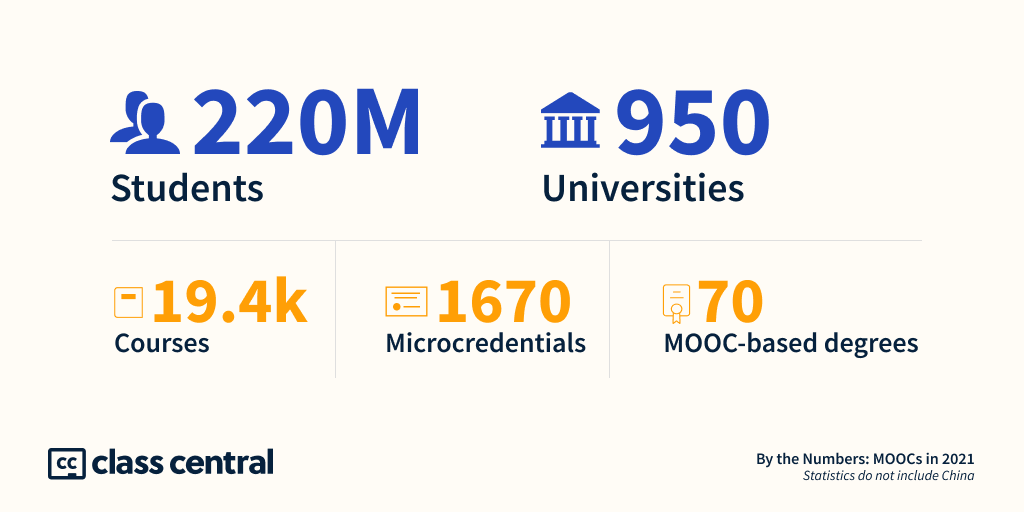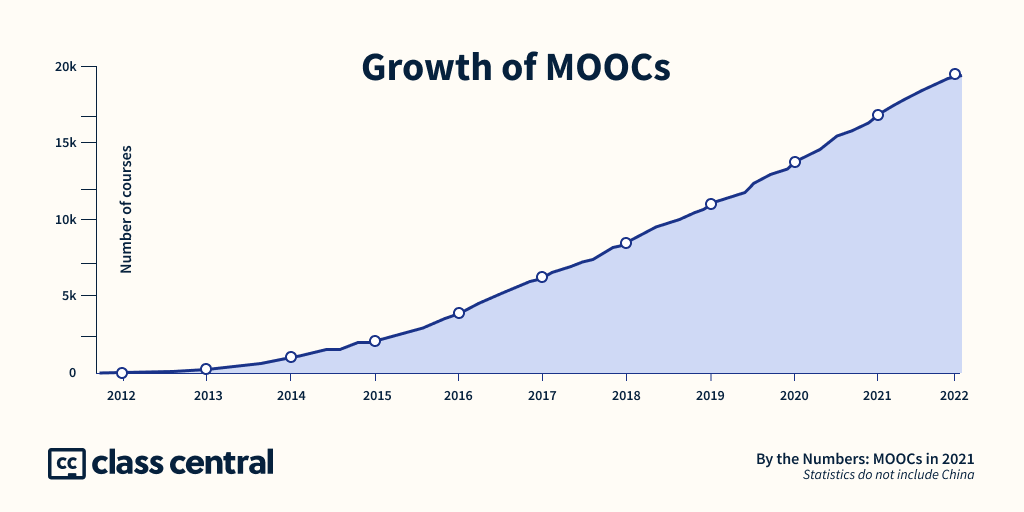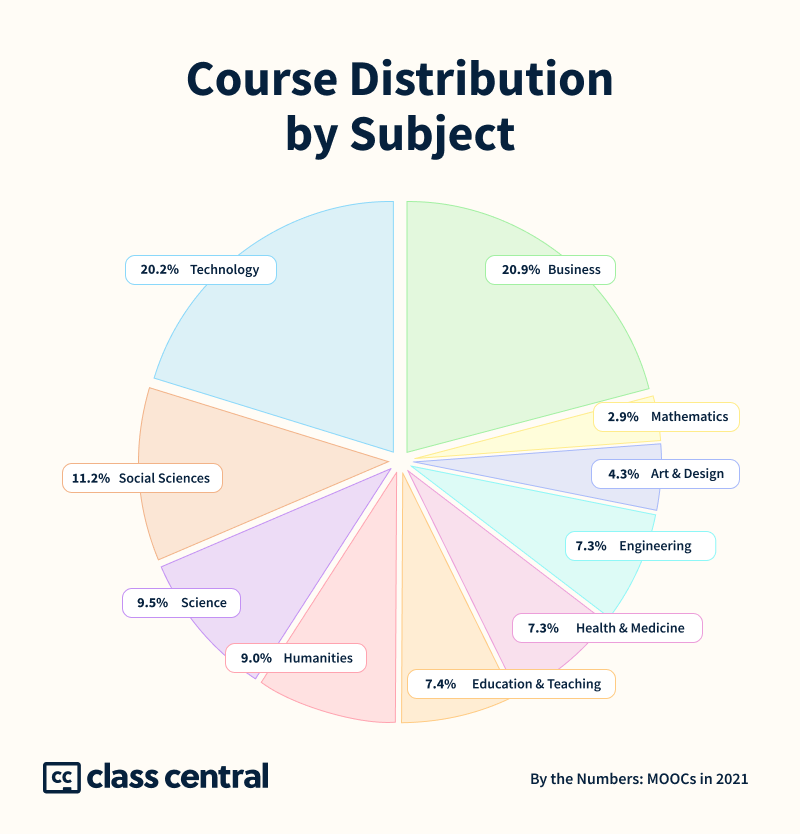By The Numbers: MOOCs in 2021
A decade has gone by since MOOCs’ popularization. They’ve now reached 220M learners. Here are the stats.
Ten years ago, over 300k learners were taking the 3 free Stanford courses that kicked off the modern MOOC movement. I was one of those learners.
Now, a decade later, MOOCs have reached 220 million learners, excluding China1. In 2021, providers launched over 3100 courses and 500 microcredentials.
In 2021, 40M new learners signed up for at least one MOOC, compared to 60M (fueled by the pandemic) in 2020.
Here’s how the top MOOC providers look in terms of users and offerings:
| Learners | Courses | Microcredentials | Degrees | |
| Coursera | 97 million | 6,0003 | 910 | 34 |
| edX | 42 million | 3,550 | 480 | 13 |
| FutureLearn 2,4 | 17 million | 1,400 | 180 | 22 |
| Swayam 2 | 22 million | 1,465 | 0 | 0 |
For Class Central‘s complete analysis, keep reading. For our previous years’ analyses, follow the links:
- By The Numbers: MOOCs in 2020
- By The Numbers: MOOCs in 2019
- By The Numbers: MOOCs in 2018
- By The Numbers: MOOCs in 2017
- By The Numbers: MOOCs in 2016
- By The Numbers: MOOCs in 2015
Courses
By the end of 2021, 19.4K MOOCs will be announced or launched by around 950 universities worldwide. In 2021 alone, around 3.1K courses were added.
Online Degrees
| 2017 | 2018 | 2019 | 2020 | 2021 | |
| Coursera | 4 | 11 | 16 | 25 | 34 |
| edX | 1 | 9 | 10 | 13 | 13 |
| FutureLearn | 4 | 18 | 23 | 28 | 22 |
2021 was the slowest year since MOOC providers began offering online degrees. Only Coursera added new degrees, while FutureLearn delisted a few.
EdX did announce a Masters in Public Health from Boston University, but it will start in 2023. Here is a complete list of MOOC-based online degrees.
Microcredentials
| Type | Provider | 2018 | 2019 | 2020 | 2021 |
| Specializations | Coursera | 310 | 400 | 570 | 820 |
| Professional Certificate | Coursera | 0 | 13 | 26 | 55 |
| MasterTrack | Coursera | 3 | 6 | 18 | 22 |
| University Certificates | Coursera | 0 | 0 | 0 | 16 |
| Professional Certificate | edX | 89 | 123 | 176 | 265 |
| MicroMasters | edX | 51 | 56 | 67 | 57 |
| XSeries | edX | 29 | 40 | 40 | 52 |
| Professional Education | edX | 62 | 73 | 94 | 97 |
| MicroBachelors | edX | 0 | 0 | 8 | 12 |
| Nanodegrees | Udacity | 35 | 40 | 73 | 82 |
| Programs | FutureLearn | 23 | 32 | 36 | 15 |
| Microcredentials | FutureLearn | 0 | 0 | 32 | 52 |
| Academic Certificates4 | FutureLearn | 14 | 17 | 18 | 16 |
| ExpertTrack | FutureLearn | 0 | 0 | 0 | 96 |
| Programs | Kadenze | 19 | 20 | 20 | 19 |
In 2021, around 500 microcredentials were added. The largest growth came from Coursera Specializations: around 250 new were introduced. Note that the Coursera Specialization numbers are inflated because Coursera launches each translation as a separate Specialization.
FutureLearn launched ExpertTrack in 2021, which are similar to Coursera Specializations. And in just a year, they’ve launched almost 100 of them.
A trend we noticed is that many of the microcredentials launched in 2021 are from companies rather than universities. For instance, companies account for two thirds of ExpertTracks.
Another recent addition are University Certificates from Coursera, which are cohort-based and have live sessions. Many of these haven’t gone live yet.
Subjects
The distribution of courses across different subjects has been relatively stable over the years, with business and technology courses accounting for 40% of all the courses.
[1] We decided to leave China out of our analysis because, as we learned more about Chinese online education, we realized that the metrics we’d like to present are: (1) sometimes unavailable, (2) sometimes available but impossible to validate to the extent we’d like, (3) sometimes reflect a view too narrow to adequately capture the overall state of MOOCs in China.
[2] For platforms with session-based courses, we counted the total number of distinct courses offered in 2021.
[3] This doesn’t include Coursera Project Network courses, since they tend to offer a light-weight learning experience compared to academic or professional Coursera courses.
[4] Graduate and postgraduate certificates are listed under microcredentials instead of under degrees.
Tags










Maite
Hi, Dhawal!
Thanks for all your work. It’s absolutely awesome! I’m doing a report in lMOOCs and I have a couple of questions. I would be grateful if you could help.
1. Can you tell me where do you integrate lMOOCs (language MOOCs)? Are they within “Humanities” category?
2. Do you know if it exists further documentation about language MOOCs? For example, most offered languages, top platforms, etc.
Thank you very much!
Maite
LI YURONG
Hello, I’m a teacher in China. I’m doing research on the MOOC platform in Asia. Do you have relevant statistics or information about the MOOC platform in Asian countries? If so, can you share it with me? I want to learn. Thank you. My email address is 396895788@qq.com , my name is Li Yurong.
Surbhi Sharma
Dear Sir,
The analytics and approximate reporting on MOOC scenario is enriching. Personally, I appreciate the Class Central Team efforts to put all the information regarding MOOCs round the globe at one place. Highly benefitted in research-related activities in MOOC by these reports.
Thank You and Warm Regards!
Surbhi
Research Fellow
Mangesh Wanjari
Hi Dhawal,
Great to see the hard work in bringing all the statistics for our access and use.
May I request you to please share details about Middle East countries’ use of MOOC. Also if ou have any specific statistics on Oman in particular, would be grateful to have those.
Thank you!
-Mangesh